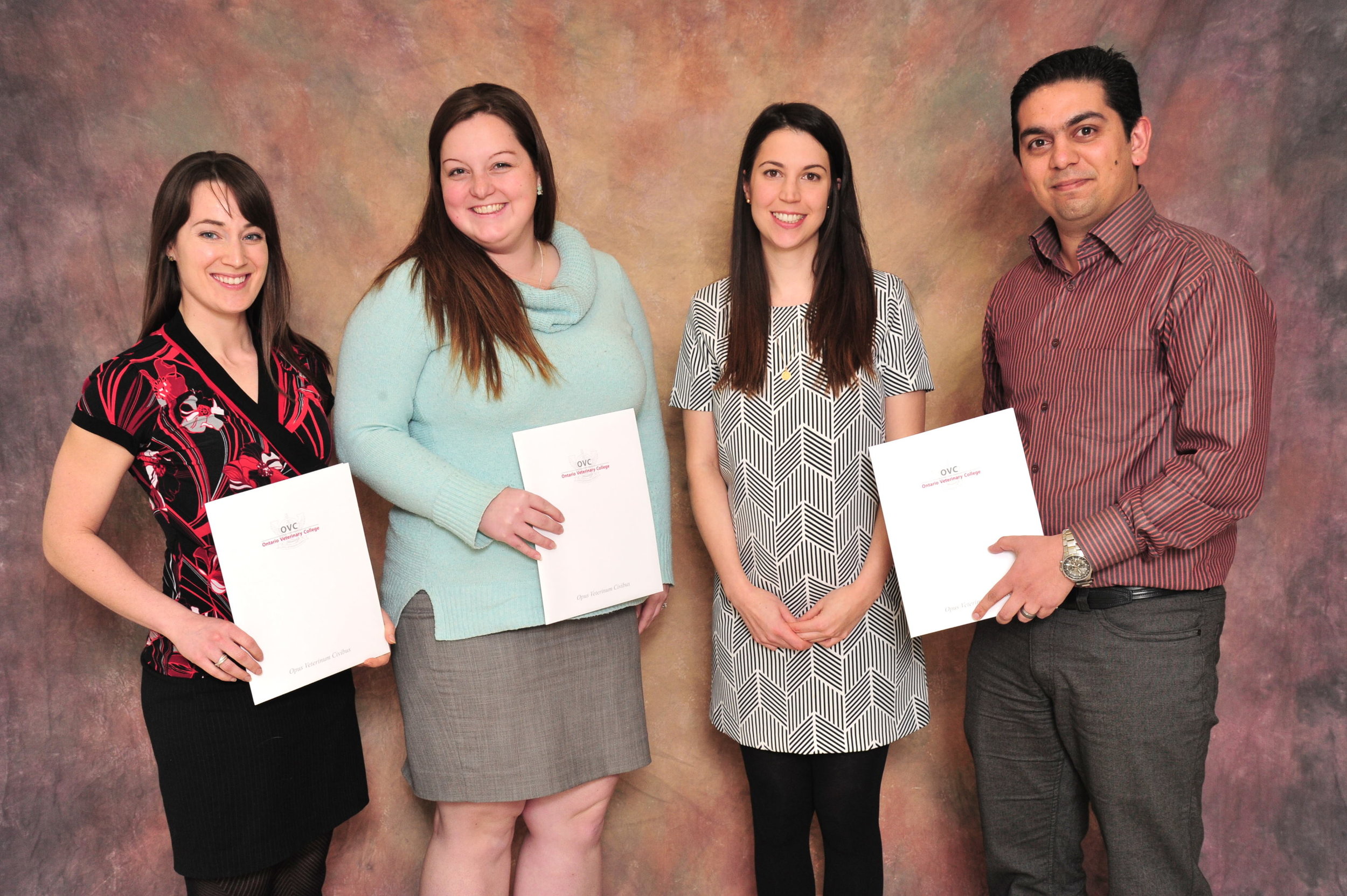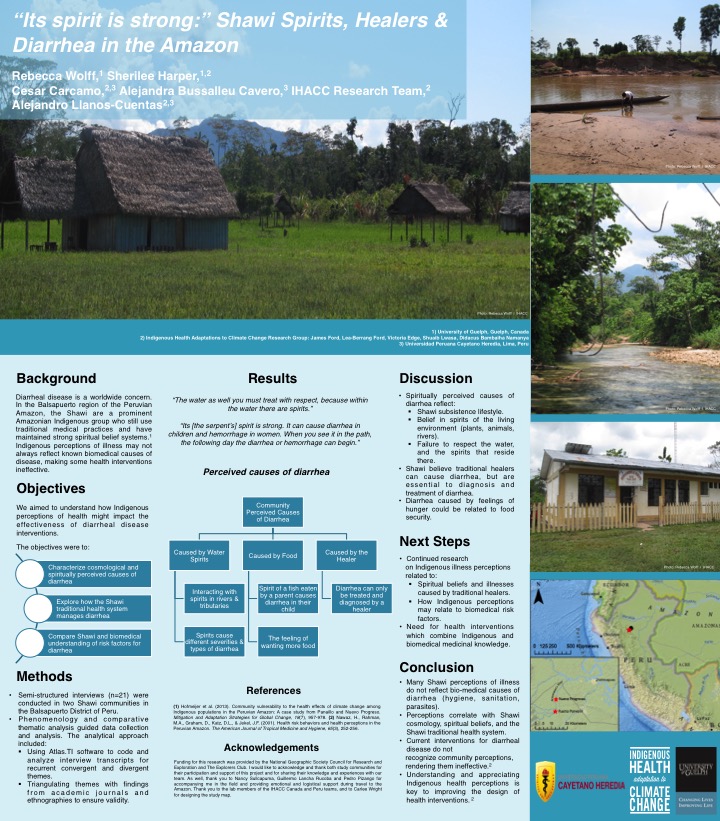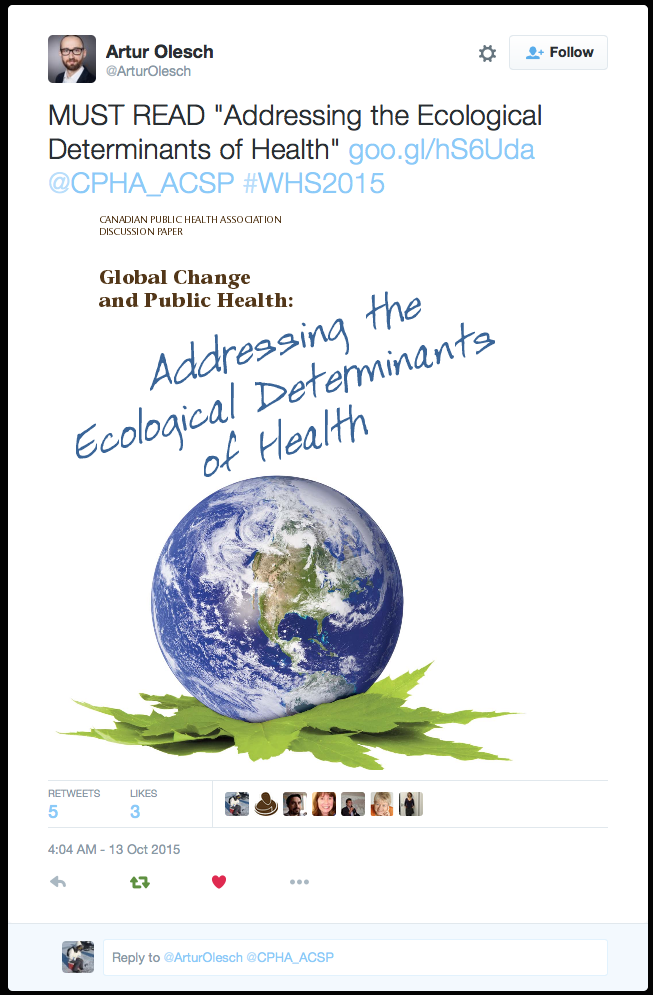Team members from the IHACC project Arctic team were in Iqaluit on Monday April 25th to host a workshop with participating community members and partners at the Nunavut Research Institute to share knowledge and insights gained throughout the 5 years of the project. Team members present included Dr. James Ford, Dr. Victoria Edge, Dr. Sherilee Harper, Dr. Ashlee Cunsolo Willox, Ms. Anna Bunce, Ms. Mya Sherman and Ms. Jolène Labbé. Workshop participants were given a wealth of materials produced from the project, including copies of scientific papers, reports, results booklets, posters, and presentations. We look forward to future collaborations in the community as IHACC moves to an end, and follow-up projects begin to take shape!
OVC Graduate Student Recognition Award Winner!
New Publication!
Congratulations to Ellen McDonald on the first publication from her MSc thesis! Citation: McDonald, E.M., Papadopoulos, A., Edge, V.L., Ford, J., IHACC Research Team, Harper, S.L. (2016). What do we know about health-related knowledge translation in the Circumpolar North? Results from a scoping review. International Journal of Circumpolar Health, 75(31223), 1-17. Click here to access the article (open access).
Title: What do we know about health-related knowledge translation in the Circumpolar North? Results from a scoping review
Abstract:
Background. Health research knowledge translation (KT) is important to improve population health outcomes. Considering social, geographical and cultural contexts, KT in Inuit communities often requires different methods than those commonly used in non-Inuit populations.
Objectives. To examine the extent, range and nature of literature about health-related KT in Inuit communities.
Design. A scoping review was conducted. A search string was used to search 2 English aggregator databases, ProQuest and EBSCOhost, on 12 March 2015. Study selection was conducted by 2 independent reviewers using inclusion and exclusion criteria. To be included, studies had to explicitly state that KT approaches were used to share human health research results in Inuit communities in the Circumpolar North. Articles that evaluated or assessed KT approaches were thematically analysed to identify and characterize elements that contributed to KT success or challenges.
Results. From 680 unique records identified in the initial search, 39 met the inclusion criteria and were retained for analysis. Of these 39 articles, 17 evaluated the KT approach used; thematic analysis identified 3 themes within these 17 articles: the value of community stakeholders as active members in the research process; the importance of local context in tailoring KT strategies and messaging; and the challenges with varying and contradictory health messaging in KT. A crosscutting gap in the literature, however, included a lack of critical assessment of community involvement in research. The review also identified a gap in assessments of KT in the literature. Research primarily focused on whether KT methods reflected the local culture and needs of the community. Assessments rarely focused on whether KT had successfully elicited its intended action.
Conclusions. This review synthesized a small but burgeoning area of research. Community engagement was important for successful KT; however, more discussion and discourse on the tensions, challenges and opportunities for improvement are necessary.
Rebecca Wolff Presents at 2016 Consortium of Universities for Global Health!
Congratulations to Rebecca Wolff for sharing her research results at the 2016 Consortium of Universities for Global Health in San Francisco! Poster citation: Wolff, R., Harper, S.L., Carcamo, C., Bussalleu Cavero, A., IHACC Research Team, and Llanos-Cuentas, A. (April 2016). “Its spirit is strong:” Shawi Spirits, Healers & Diarrhea in the Peruvian Amazon. Consortium of Universities for Global Health 2016 Conference, San Francisco, USA.
InukBook covered by Canadian Geographic
The InukBook program was recently highlighted by Canadian Geographic in an interview with Dr. Ashlee Cunsolo. "Thawing permafrost and other changes in weather and precipitation patterns are having a number of adverse effects on Inuit culture, not the least of which being climate change-related health impacts like increased risk of injury due to unstable ice. Today, “monitoring” is the foremost recommended health/climate strategy. Many monitoring structures in place in the North, however, aren’t organized to reflect the values and preferences of Indigenous people. Cue the InukSUK program (with SUK standing for strength, understanding and knowledge, principles that underpin Inuit notions of health and wellbeing)...." Click here to read the article.
Congrats to Nia King on her National 3M Award!
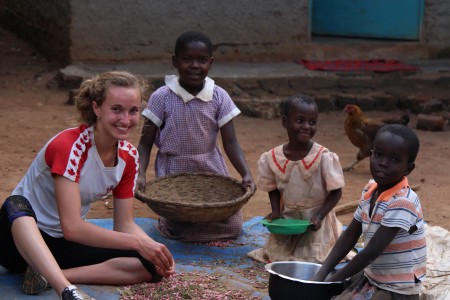
Congrats to Lab Member Nia King for her National 3M Award, recognizing her work with Dr. Cate Dewey in Kenya.
For more information, click here.
PhotoVoices of the Harper Lab: Reflections on the Health-Place Nexus
Written by Alexandra Sawatzky, PhD student Over the course of this semester, members of our lab group have been taking turns facilitating our bi-weekly lab meetings. Jacquie and I were in charge of last week’s meeting, and given that the end of the semester is fast approaching, we thought we would take the opportunity to lead an activity that might help to alleviate some of the end-of-semester stress while also encouraging some self-reflection.
A lot can happen in one semester. The months often fly by without leaving us much time to reflect on what we’ve learned, or how much we’ve grown. It’s easy to feel a little lost and overwhelmed amidst all of the coursework, teaching, travel, and extracurriculars.
“Stress management” techniques such as getting enough sleep, meditation, and exercising can be helpful, but they don’t necessarily help you tackle the root of the problem. Increasing attention has been paid to the benefits of self-reflection, specifically in terms of articulating those “…core values that help us weather the storms and devastations that inevitably rock our lives and careers…followed by action steps to implement those values in interpersonal settings” (Brendel, 2015).
One way to help identify those core values is to reflect on the places that play a role in shaping who you are and how you perceive the world. For example, Basso (1996), writing within the context of a Western Apache tribe, talks about stepping back from everyday experiences and incorporating an awareness of sense of place into self-reflection:
“places possess a marked capacity for triggering acts of self-reflection, inspiring thoughts about who one presently is, or memories of who one used to be, or musings on who one might become” (p. 55).
As such, reflecting on the way certain places make us feel can help us to assess and deal with our current situations, as well as work towards improving our future. Identifying the places where you feel most connected to the world – and to yourself, for that matter – and making conscious efforts to continue connecting with those places can help you to develop your own personal recipe for resilience during stressful times.
Recognizing that we certainly couldn’t accomplish all this in an hour, Jacquie and I came up with a more focused self-reflection exercise, using a photovoice framework. Following an approach laid out by Mulder and Dull (2014) involving the use of photovoice to encourage self-reflection and self-awareness among Master’s of Social Work students, we sought to turn the focus of this method inward, towards ourselves as graduate students.
We asked members of our lab group to share photos of places that were important to them. We encouraged each person to describe why each place was important, how it came to be important, as well as how that place made them feel.
Essentially, these places were important because they told stories. As everyone shared their photos and associated stories, several cross-cutting themes became clear.
- We use these places as a means to describe our past experiences as well as our future goals. Often, we choose our favourite places based on where we feel most ourselves, or where we feel the best parts of ourselves are brought out. These are places where we get much of our thinking done. From reflecting on past experiences, to envisioning our future, these places, as one individual stated, are “…where everything comes together – [they] put everything in perspective, and help with making decisions.”
- Familiar places instill in us a sense of consistency. We draw a lot of meaning from places we visit often. Even though we may change substantially between the times where we get to visit these places, we can usually count on the environment itself to stay relatively the same. One person even mentioned that, “it’s been many years since I’ve been there, yet I still know it so well.”
- Discovering and exploring new places was associated with turning points, or life-changing moments that led to growth, change, and independence. As such, new places can become just as important as places we’ve known our whole lives. It’s a strange but wonderful feeling when you are able to instantly adapt to/fall in love with a new place.
- With everything we have going on in our lives, sometimes finding a healthy balance seems impossible. As such, we tend to gravitate towards certain places as a sort of escape from reality. Interestingly, the places each of us went to “get away from it all” were just as distinct and diverse as the things we are trying to get away from. However, these places all served a common purpose: for us to reset, rejuvenate, and renew ourselves.
- These places are special, and the people we’re with make them that much more special. Although the relationship we have with these places are highly personal, friends and family have a strong influence on the depth of our relationship to a certain place. Indeed, our relationships with other people can be an integral part of our relationships with places. For example, when speaking about a place she visited with her family, one individual said, “I am really influenced by the people around me. I love being around jovial groups – people who are as excited as I am to be there.”
- Certain spots make you feel as though you are in exactly the right place, at exactly the right time. It takes a special place to make us feel fully present and truly peaceful.
Overall, this activity encouraged us to discuss some of the places we hold close to our hearts, and explore how these places helped lead to the development of our values and perceptions. Our discussions combined introspection, creativity, and the integration of multiple perspectives into a comprehensive self-reflection process.
Identifying and understanding those places where we feel most connected can also help us on our journey toward figuring out who we are and what we value. These places serve to remind us where we come from, as well as reveal how much we’ve grown. New places can help us look at old places in different ways, and perhaps understand more deeply what these mean to us.
We need these places for so many reasons – for all aspects of wellbeing. However, these places don’t necessarily need us in this same way. It’s easy to forget that when we’re not in that place, the place is still there. Indeed, our favourite places will be there long after we’re gone. These places give us so much – a sense of connectedness, feelings of peace and tranquility – we don’t think about what or how we can give back. Or if we can give back at all. Maybe the best thing we can give back is simply our pure and utmost gratitude.
References:
Basso, K. H. (1996). “Wisdom Sits in Places: Notes on a Western Apache Landscape.” In Feld, Steven, and Basso (eds.) Senses of Place. Santa Fe: School of American Research Press, 53-90.
Brendel, D. (2015). “Manage Stress by Knowing What You Value.” Harvard Business Review. Retrieved from: https://hbr.org/2015/09/manage-stress-by-knowing-what-you-value
Mulder, C., and Dull, A. (2014). Facilitating self-reflection: the integration of photovoice in graduate social work education. Social Work Education, 33(8):1017-1036.
MSc Graduate Sarah Syer Transitions from Researching Paediatric Malnutrition to Childhood Cerebral Palsy!
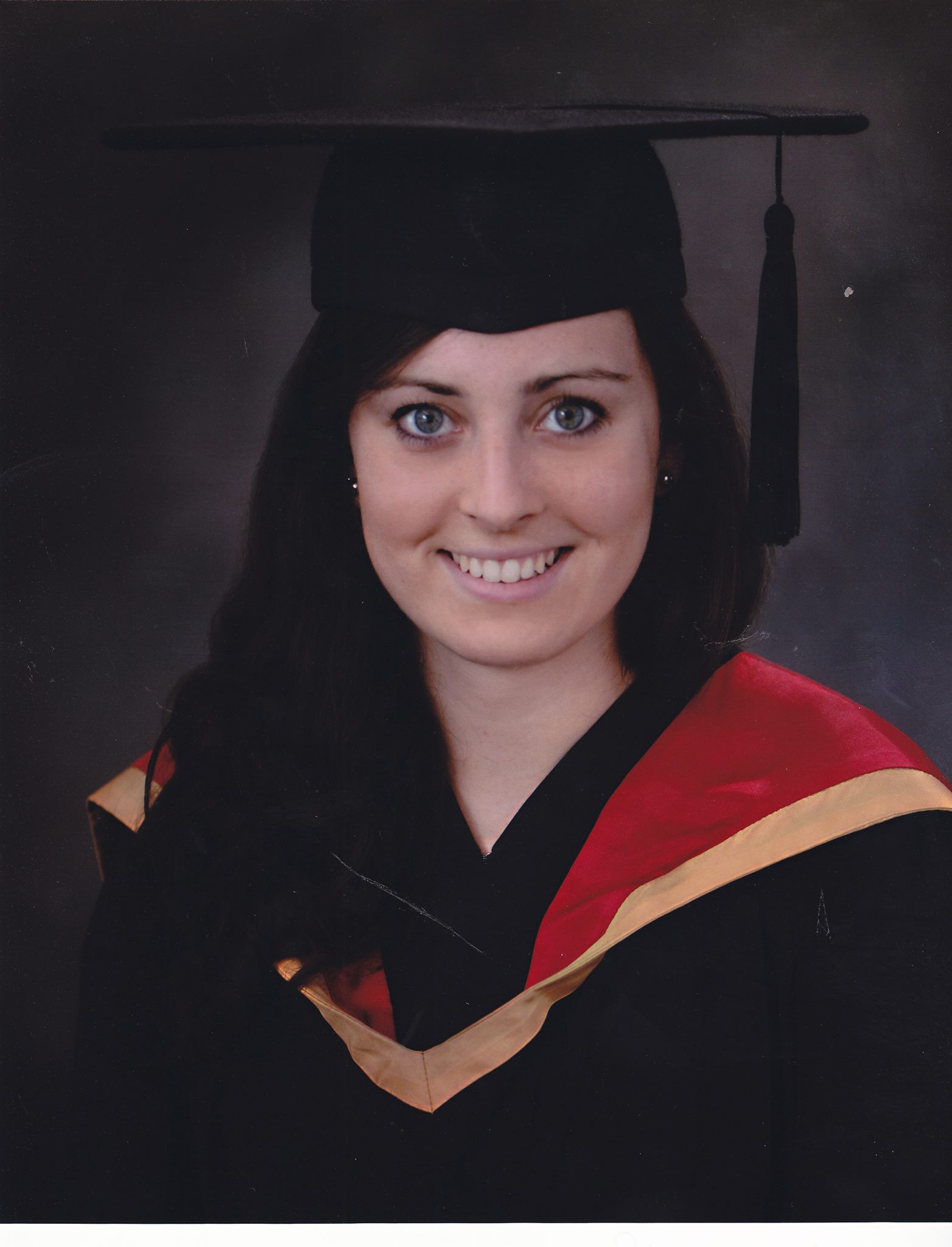 After graduating from the EcoHealth Lab where she studied childhood malnutrition, Sarah Syer is continuing her health research career as a Research Assistant at ErinoakKids Centre for Treatment and Development (Mississauga). The research project she is working on is funded by the Ontario Brain Institute (OBI) and is called CP-NET (Childhood Cerebral Palsy Integrated Neuroscience Discovery Network), which aims to improve the understanding of cerebral palsy and accelerate the development of new treatments. She is working closely with a developmental paediatrician, who is the principle investigator at the ErinoakKids site.
Interested in learning more about the organization that Sarah is now working with? Click below to learn more about OBI's plan and goals for the project:
After graduating from the EcoHealth Lab where she studied childhood malnutrition, Sarah Syer is continuing her health research career as a Research Assistant at ErinoakKids Centre for Treatment and Development (Mississauga). The research project she is working on is funded by the Ontario Brain Institute (OBI) and is called CP-NET (Childhood Cerebral Palsy Integrated Neuroscience Discovery Network), which aims to improve the understanding of cerebral palsy and accelerate the development of new treatments. She is working closely with a developmental paediatrician, who is the principle investigator at the ErinoakKids site.
Interested in learning more about the organization that Sarah is now working with? Click below to learn more about OBI's plan and goals for the project:
http://www.braininstitute.ca/cpnet/CP-intro.html
Farewell and congratulations Sarah!
Best of luck with all of your future endeavours and adventures!
Climate Change IFS3 Meeting with Ugandan Colleagues
Last week we convened in Montreal for productive, insightful, and fun meetings with colleagues from Uganda, South Africa, and McGill to begin planning for the Climate Change and Indigenous Food Systems, Indigenous Food Security, and Indigenous Food Safety (Climate Change IFS3) project.
Alexandra Sawatzky Reflects on her Work in Rigolet, Nunatsiavut
Written by Alexandra Sawatzky (PhD Student) Almost immediately upon returning from my trip to Rigolet in February, I was faced with the unavoidable, arguably unanswerable, question: so, how was it?
Even after having had time to reflect and process everything, I still struggle with answering this question. There is no way I can articulate exactly how I feel about Rigolet, about the incredible people I get to work with here, and about the project that I am lucky enough to be a part of. I think this struggle with putting my feelings into words is largely due to the fact that the project, the people, and the place are all intertwined, and they all became a part of my life so easily and so quickly that my words have trouble catching up to my emotions.
Before my first trip to Rigolet this past October, I was incredibly nervous. I was so intimidated at the prospect of being involved in such a large, interdisciplinary project. I didn't exactly know where I would fit, let alone what the community would think of me. But as soon as I stepped off that first Air Labrador flight, all my fears disappeared and I knew I would never be the same.
Fast forward a few months, and before I knew it, I was back on a plane headed North with Dan, Oliver, and Ashlee. It was an amazing feeling, and an enormous privilege, to have the opportunity to return to Rigolet. Again, I was nervous, but this time my pre-trip jitters had more to do with being overwhelmingly excited to continue moving this project forward, to reconnect with people in the community, and to experience winter in all its Northern glory.
For a bit of background, our research involves the participatory development of a surveillance system, led by the community of Rigolet, to to track and respond to changes in the environment and resulting impacts on health and wellbeing. The basis of the approach we're taking to build this project is to listen, learn, understand, and then respond to what the community needs and wants. To start this process, back In October we asked members of the community five main questions in a series of interviews and focus groups: (1) what are some important issues with regards to the environment and health; (2) what sorts of changes in the environment and resulting health impacts are you noticing in your community; (3) of these changes, what do you think is important to monitor/track; (4) how are you already keeping track of these changes; and (5) what sorts of tools/technologies (if any) are you using to do so?
As I was preparing to return in February, I thought critically about what we had learned from the community thus far, and how we might build off these initial discussions surrounding important environment-and health-related issues. However, in order to build from these discussions and move forward with the project in an appropriate way, I first needed to develop a deeper understanding of the reasons why these issues were important, who they were important to, and how they were prioritized. In short, I needed to ask some new questions.
I sat down with many of the same individuals who I had met with in October to present the preliminary findings and ask for their feedback. Then, I asked: (1) why are these issues important to you; (2) how would you prioritize these issues; (3) what are some ideas you have that could help make this program engaging and easy for people to use?
With each person or group I spoke with, my mind was blown over and over again by the depth and breadth of wisdom that is held in Rigolet. One of the key points brought up in this round of brainstorming sessions was that we need to work together to create a program that wouldn't necessarily feel like a "program" - we need to create something that can be seamlessly incorporated into day-to-day life. Conversations like these made me realize over and over again what an honour it is to be working with and learning from this community. As always, the ways in which people described their connections to and relationships with the land absolutely blew me away. Although I will never even begin to know the true depth of the love that’s shared here between the land and its people, I am so grateful to be taking part in this learning journey.
During our trip, we also had the opportunity to engage in some hands-on, experiential learning on the land. Within a few hours of arriving in Rigolet, we took off with Sandi and Karl - our gracious hosts and dear friends - to spend the weekend at their cabin on English River – about a 2.5-hour skidoo ride outside of the community (mind you, this same trip typically takes Sandi and Karl about 1.5 hours). From the moment we left, we knew this would be the adventure of a lifetime. We left Rigolet in the late afternoon, and as we were making our way across Lake Melville we witnessed the most stunning sunset any of us have ever seen. The only description that somewhat captures this experience is that it felt like gliding above the surface of the clouds; hard to tell where the ice ended and the sky began. Unfortunately, I don’t have any photos of this magical experience because it was way too cold to stop and pull out my camera. Yet, there is something to be said for just living in the moment and absorbing the surroundings without viewing them through a lens. Moreover, there is no way a photo could have captured that kind of beauty anyway (at least, no photo that I could take).
Our weekend at the cabin was filled with fun, adventures, and delicious food (everything tastes better when cooked on a wood stove). We had a massively successful ice fishing escapade, and Oliver and I even skinned our first rabbits under Sandi’s patient instruction and watchful eye. Sandi and Karl, I don’t think we can thank you enough for keeping us full, safe, warm, and smiling.
This experience also gave us many important insights that will be absolutely crucial to incorporate into our project as we learn to better understand how technological tools can help people keep track of various environmental observations and changes while they are on the land. For example, our phones and cameras would freeze at times, so using them outside in certain conditions was not feasible and is something we need to account for in developing the project. There was definitely something to be said about learning how to navigate through these unanticipated challenges firsthand.
Upon reflection, I am realizing that this project, these people, and this place all share the same part of my heart - a part of my heart that I most certainly didn’t realize was missing until I found it. I feel so fortunate to be working with a team of community partners and researchers that is so incredibly supportive of each other. We hold the same basic values, share a deep and indescribable love of the North, and we take our research as seriously as we do our long underwear and scavenger hunts. Through these experiences, I’m finding that in order to do your best work and be your best self, it helps to be surrounded by people who bring out the best parts of you.
In terms of the place, its immense beauty never ceases to amaze me. There are really no words, only feelings. The colours are brighter, the food is tastier, the air is fresher, and life feels more authentic. It’s a place where I can let my guard down, open myself to change, and challenge myself to grow. But no matter what I say about it or how I try to describe it, there is so much more that I can't even begin to describe. That which no words can capture. I truly feel as though I left a part of my heart there. This is something I struggle with articulating because I know that no matter how much I learn about/love this place, I will always be an outsider, a stranger to the land. I will never know the love that these people have for their homeland, and that which the land has for them. So thank you, Rigolet, for welcoming us Southerners with open arms and allowing us to share in your incredible beauty and wonder. As I'm slowly running out of words to capture how I feel about working, learning, loving, and growing in this place, I'll call upon the help of Richard Wagamese, an Ojibway author:
“To be struck by the magnificence of nature is to be returned again, in those all too brief moments, to the innocence that we were born in. Awe. Wonder. Humility. We draw it into use and are altered forever by the unquestionable presence of the Creator. All things ringing true together. Carrying that deep sense of communion back into our work-day life, everyone we meet becomes the direct beneficiary of our having taken the time for connection, prayer, and gratitude. This is what we are here for - to remind each other of where the truth lies and the power of simple ceremony.”
Community Consultations on the PAWS Project
Written by Anna Bunce Consultations for the People, Animals, Water, and Sustenance (PAWS) project continued last week in Iqaluit as Dr. Jan Sargeant and myself were in town meeting with community stakeholders to determine the priorities for the quantitative portion of the work. As a goal of this work is to provide useful, relevant information to stakeholders we have been consulting with a variety of stakeholders in Iqaluit since the idea for this project first came to be. Last week was just another part of our consultation, but an exciting one. Dr. Sargeant and I presented a series of potential scenarios to stakeholders and asked them to help prioritize which pathogens we should test for and what sources we should test. With so many options it immediately became clear that we would need something to break down all the options, and so a “menu” of sorts was created, laying out the options of what pathogens we could look at and which sources we could test for these various pathogens. The outcome was a very productive and informative meeting, where we were able to brainstorm ideas and talk about the pros and cons of each possible scenario. After having a “dotmocracy” session, where stakeholders ranked their preferences using a series of dots, we have a clearer idea of priority areas and are looking forward to following up with more meetings in March. A big thank you again to all the stakeholders who took time out of their busy day to meet with us!
Anna Bunce is the project manager for the PAWS Project. Having recently completed her Masters at McGill University looking at how Inuit women are experiencing and adapting to climate change in Iqaluit, she is excited to continue working in Iqaluit, Nunavut with the PAWS project.
Congratulations to Sarah Syer for Completing her MSc!
Congratulations to Sarah Syer for successfully defending her MSc research in January, and convocating with a MSc in Epidemiology this week! Photos below: Sarah at the UofG Grad Lounge receiving her customary Defense Mug; Sarah at UofG Convocation
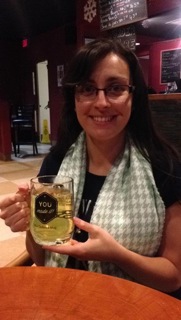
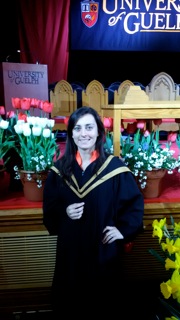
Summer Undergraduate Research Assistant Needed!
We are hiring a summer undergraduate research assistant. Please see the job post and application instructions for details: https://www.uoguelph.ca/registrar/studentfinance/ura/jobs/ids/221
Report was #1 Story! CPHA Discussion Paper on the Ecological Determinants of Health
The Canadian Public Health Association published a report entitled, "Addressing the Ecological Determinants of Health" in May 2015. The report has received attention from academics, policy makers, and media - and recently ranked as the CPHA's #1 most-read item for 2015! Click here to view the report (free, open-access).
This discussion document was based on the report Global Change and Public Health: Addressing the Ecological Determinants of Health: The Report in Brief developed by a Canadian Public Health Association (CPHA) working group:
- Lead Author: Trevor Hancock
- Lead Editors: Donald W. Spady and Colin L. Soskolne
- Chapter 1: Trevor Hancock, Donald W. Spady
- Chapter 2: Donald W. Spady, Trevor Hancock,
- Chapter 3: Trevor Hancock, George McKibbon, Colin L. Soskolne, Donald W. Spady
- Chapter 4: Sandra Allison, Sherilee Harper, Blake Poland, Trevor Hancock
- Chapter 5: Colin L. Soskolne, Donald W. Spady, Trevor Hancock
- Chapter 6: Margot Parkes, Andrea Chircop, George McKibbon, Blake Poland, Trevor Hancock
- Chapter 7: Trevor Hancock, Blake Poland, Margot Parkes, Andrea Chircop, George McKibbon
- Chapter 8: Trevor Hancock, all authors
Student Reflection: ArcticNet ASM 2015 – Vancouver, BC December 7-11, 2015
Written by Lindsay Day, MSc Candidate
This year’s Arctic Net Annual Scientific Meeting in Vancouver did not disappoint as a fabulous conference to attend. In addition, it also marked the launch of a survey I am doing as part of my thesis research, looking at the practices and approaches being used to bring Indigenous and Western knowledge together in Northern-focused research, practice and policy.
The survey builds on, and aims to assess on a broader scale, some of the key findings from in-depth interviews I’ve conducted with university and community-based researchers who have sought to bring together Indigenous and Western knowledge in their work addressing issues at the intersection of ecosystem and human health.
As the largest annual Arctic research conference in Canada, ArcticNet was certainly the perfect venue for us to promote the survey and I’m thoroughly grateful for the support the ArcticNet team provided. Overall we collected over 300 survey responses! I can’t wait to analyze the data to see what we find and I look forward to sharing the results next year!
Graduate Student Exam Stress Relief Kits: Made by Manpreet Saini
Student Reflection: ArcticNet ASM 2015 – Vancouver, BC December 7-11, 2015
Written by Carlee Wright, MSc Candidate
Last week, along with several other lab mates, I had the opportunity to travel to Vancouver for the 11th ArcticNet Annual Scientific Meeting (ASM). This was my second year attending ArcticNet ASM, and once again I was impressed by all the different aspects of the conference!
Student day was packed full of sessions centered around the theme of professional development, and during this time we were also able to meet other graduate students and learn about the work they are doing. It was great to see familiar faces around the conference during the course of the week!
With so many different topical sessions it was hard to decide which ones to attend. Through the talks I learned about many different research projects, from fox rabies to muskox health, and even Arctic search and rescue! Although my research is water-focused, I really enjoyed listening to talks on topics different from my own; seeing the vast range of work being done is exciting, and it helps me to put my own work in perspective in the scope of Arctic research at large.
The ArcticNet Student Association also organized a great cultural night, where we could either make a seal skin bracelet, try our hand at beading patterns, or play traditional Inuit games. It had a great turnout and was a really fun way to relax after a long week of events and topical sessions.
This year's ArcticNet ASM was once again a great experience, and I look forward to being able to attend again in the future!
Student Reflection: ArcticNet ASM 2015 – Vancouver, BC December 7-11, 2015
Written by Manpreet Saini, MSc Candidate
This past week I was fortunate enough to attend and participate in the ArcticNet Scientific Meeting. This conference was overall, a great experience and I probably will not be able to do my experience justice with the following reflection. The week started with Student Day on Monday and I was privileged to attend the workshop titled “How Researchers Can Maximize Engagement with Traditional Knowledge (TK) and Communities”. This workshop was led by Shelly Elverum, Eric Solomon, and Inuit individuals including, Mia Otokiak, Coral Westwood, and Andrew Arreak. The most interesting part of the workshop was an activity that demonstrated the difference in worldviews and perceptions when thinking of issues Northern Inuit communities face. First, the audience had to list issues that we believed were important to Northern Inuit communities. Following this the Inuit youth listed the issues their communities had identified. While some of the things listed by each group were similar to one another, some were different. For instance, the Inuit communities were quite concerned with garbage collection and yet the researchers did not have this on their list. It was humbling to see this difference and it was a reminder of the importance to understand different worldviews without projecting your own worldview as the only "true" worldview. It was a great discussion session that made me once again reflect on the importance of the language that researchers use and the way in which researchers approach projects for Inuit communities.
Over a period of time on Tuesday and Wednesday evening, we had the opportunity to participate in two poster presentation sessions. These sessions allowed us to interact with individuals from various backgrounds and share our research as well as learn about research in areas outside of our own. For topical sessions, I had the pleasure of sitting in talks regarding the one health approach and knowledge co-production. Through these presentations it was wonderful to see the variety of projects incorporating human, animal and environmental health and also the inclusion of Inuit community members within these projects.
On Wednesday night there was also a scheduled cultural night. There were tables set up where you could learn and participate in a variety of traditional activities such as beading, making a seal skin bracelet and playing traditional games. Luckily, we got a chance to participate in making a seal skin bracelet, which was a very neat experience!
Finally, on Thursday I did an oral presentation for the first time which was both exciting and extremely nerve-wracking. However, I had tremendous support through an extremely thoughtful Facebook post from Inez Shiwak, who unfortunately could not be there to co-present with me, and through the presence of many familiar faces in the room!
Throughout the week, I had the chance to both reconnect with collaborators and to meet various new individuals. Overall, ArcticNet Annual Scientific Meeting was just an incredible experience and it was an honour to be able to participate and share our work on behalf of myself and my co-authors.
Lab Members Win Poster Presentation Prizes at ArcticNet Annual Scientific Meeting!
EcoHealth Lab at ArcticNet ASM 2015!
ArcticNet hosted its 11th Annual Scientific Meeting (ASM) from 7 to 11 December in Vancouver, British Columbia. The ASM2015 welcomed 650 researchers, students, Northerners, policy makers and stakeholders to "address the numerous environmental, social, economical and political challenges and opportunities that are emerging from climate change and modernization in the Arctic."
The EcoHealth lab collaborated in 6 poster presentations, 7 oral presentations, and 1 topical session.
Posters:
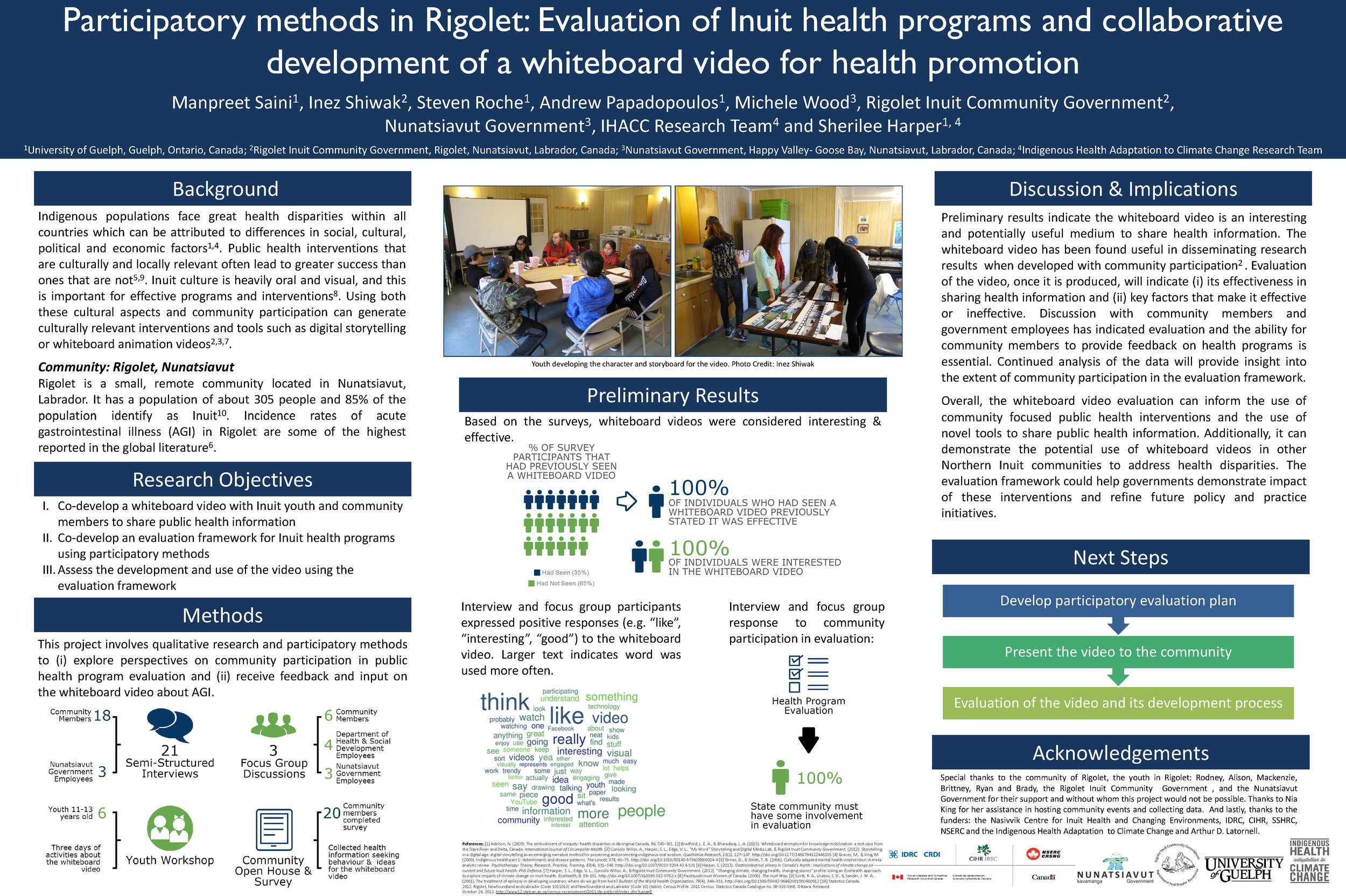 Saini M, Shiwak I, Roche S, Papadopoulos A, Wood M, Rigolet Inuit Community Government, Nunatsiavut Government, IHACC Research Team and SL Harper. December 2015. Participatory methods in Rigolet: Evaluation of Inuit health programs and collaborative development of a whiteboard video for health promotion. Poster Presentation. 11th ArcticNet Annual Scientific Meeting. Vancouver, Canada.
Saini M, Shiwak I, Roche S, Papadopoulos A, Wood M, Rigolet Inuit Community Government, Nunatsiavut Government, IHACC Research Team and SL Harper. December 2015. Participatory methods in Rigolet: Evaluation of Inuit health programs and collaborative development of a whiteboard video for health promotion. Poster Presentation. 11th ArcticNet Annual Scientific Meeting. Vancouver, Canada.
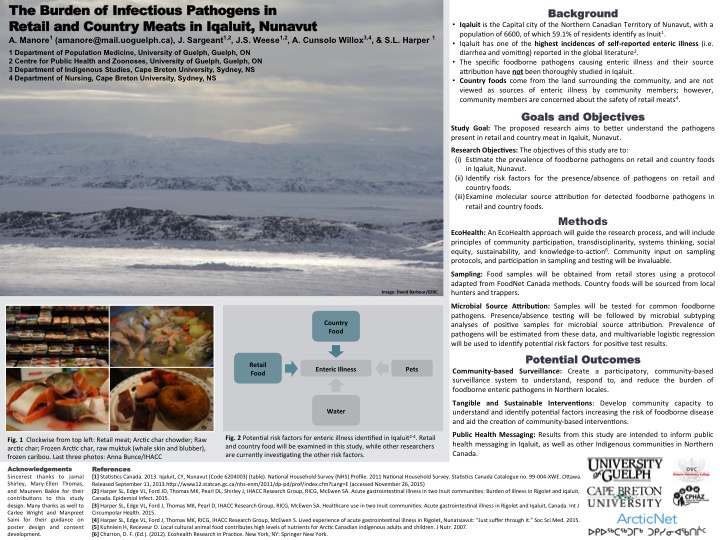 Manore A, Sargeant J, Weese JS, Cunsolo Willox A and Harper SL. December 2015. The burden of infectious pathogens in retail and country meats in Iqaluit, Nunavut. Poster Presentation. 11th ArcticNet Annual Scientific Meeting. Vancouver, Canada.
Manore A, Sargeant J, Weese JS, Cunsolo Willox A and Harper SL. December 2015. The burden of infectious pathogens in retail and country meats in Iqaluit, Nunavut. Poster Presentation. 11th ArcticNet Annual Scientific Meeting. Vancouver, Canada.
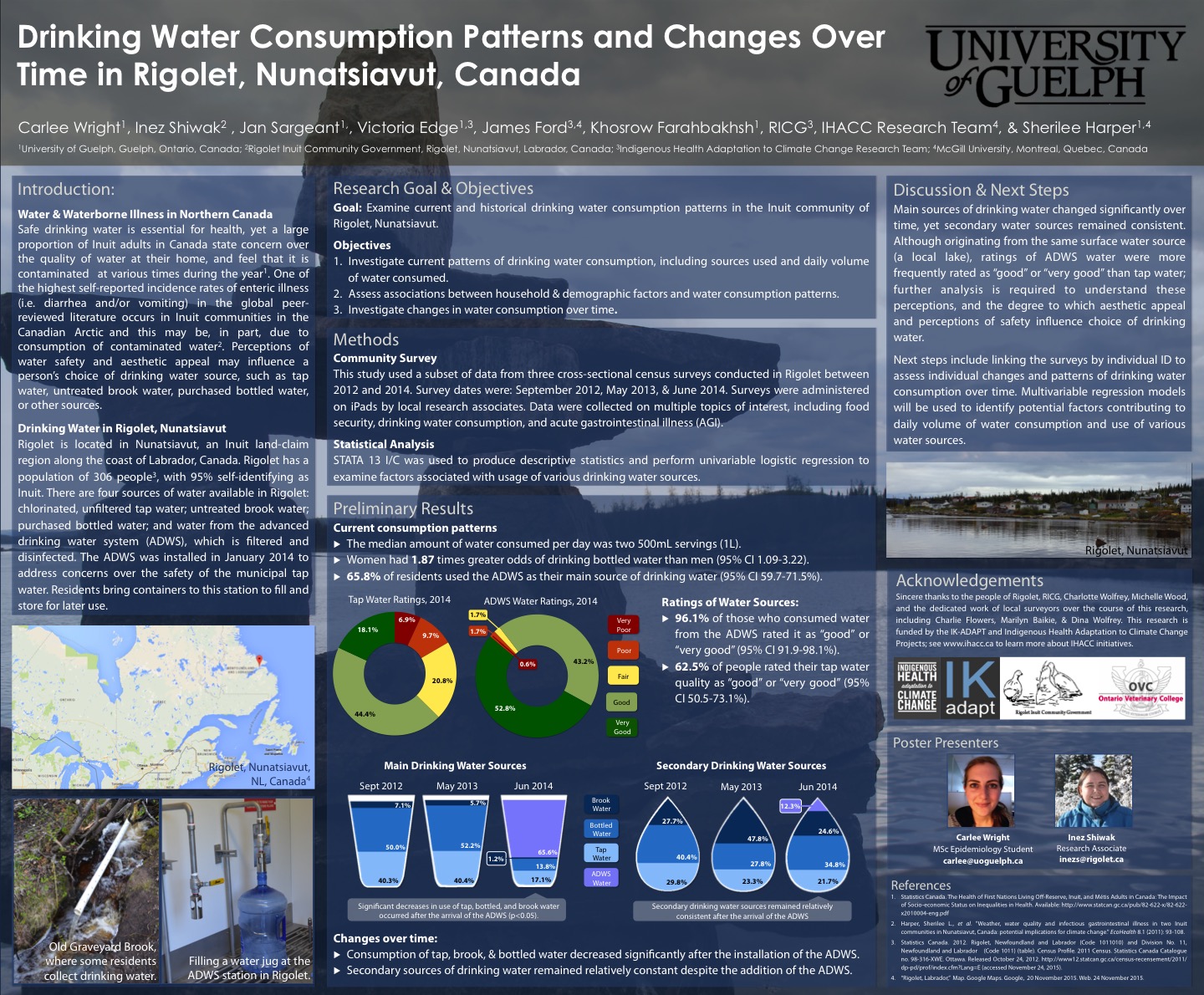 Wright C, Shiwak I, Sargeant J, Edge V, Ford J, Farahbakhsh K, Rigolet Inuit Community Government, Nunatsiavut Government, IHACC Research Team and SL Harper. December 2015. Drinking water consumption patterns and changes over time in Rigolet, Nunatsiavut. Poster Presentation. 11th ArcticNet Annual Scientific Meeting, Vancouver, Canada.
Wright C, Shiwak I, Sargeant J, Edge V, Ford J, Farahbakhsh K, Rigolet Inuit Community Government, Nunatsiavut Government, IHACC Research Team and SL Harper. December 2015. Drinking water consumption patterns and changes over time in Rigolet, Nunatsiavut. Poster Presentation. 11th ArcticNet Annual Scientific Meeting, Vancouver, Canada.
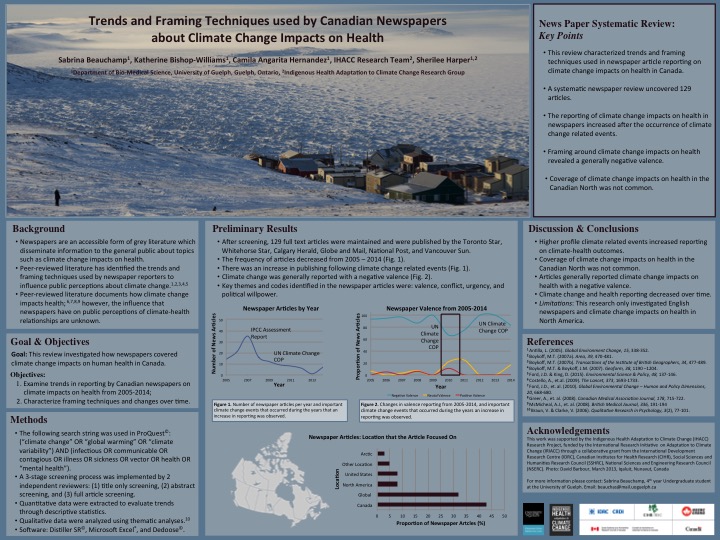 Beauchamp SL, Bishop-Williams KE, Hernandez CA, IHACC Research Team and SL Harper. December 2015. Trends and framing techniques used by Canadian newspapers about climate change impacts on health. Poster Presentation. 11th ArcticNet Annual Scientific Meeting, Vancouver, Canada.
Beauchamp SL, Bishop-Williams KE, Hernandez CA, IHACC Research Team and SL Harper. December 2015. Trends and framing techniques used by Canadian newspapers about climate change impacts on health. Poster Presentation. 11th ArcticNet Annual Scientific Meeting, Vancouver, Canada.
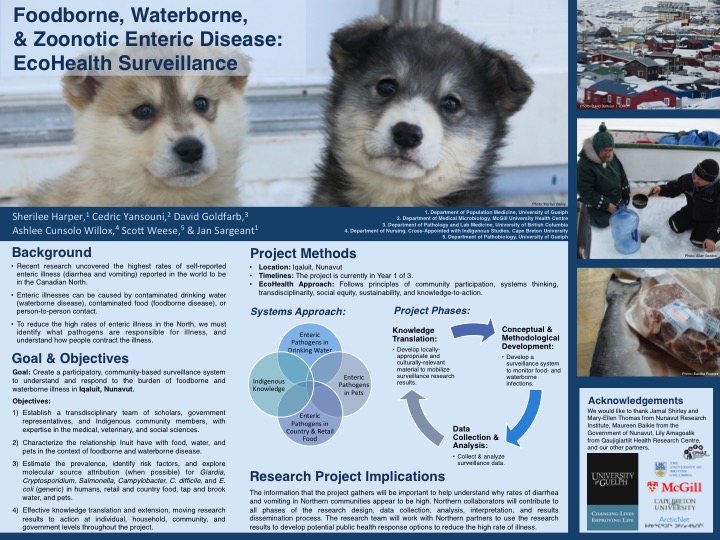 Harper SL, Yansouni C, Goldfarb D, Cunsolo Willox A, Weese S, and J Sargeant. December 2015. Foodborne, waterborne, and zoonotic enteric disease: EcoHealth surveillance for environmental health. Poster Presentation. 11th ArcticNet Annual Scientific Meeting, Vancouver, Canada.
Harper SL, Yansouni C, Goldfarb D, Cunsolo Willox A, Weese S, and J Sargeant. December 2015. Foodborne, waterborne, and zoonotic enteric disease: EcoHealth surveillance for environmental health. Poster Presentation. 11th ArcticNet Annual Scientific Meeting, Vancouver, Canada.
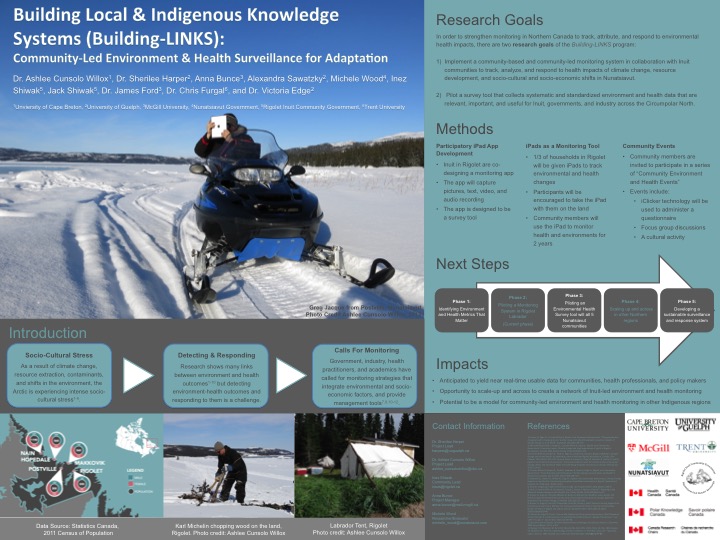 Cunsolo Willox A, Harper SL, Bunce A, Gillis D, Sawatzky A, Shiwak I, Shiwak J, Ford J, Furgal C, and VL Edge. Building Local & Indigenous Knowledge Systems (Building LINKS): Community-led environment & health surveillance for adaptation. Poster Presentation. 11th ArcticNet Annual Scientific Meeting, Vancouver, Canada.
Cunsolo Willox A, Harper SL, Bunce A, Gillis D, Sawatzky A, Shiwak I, Shiwak J, Ford J, Furgal C, and VL Edge. Building Local & Indigenous Knowledge Systems (Building LINKS): Community-led environment & health surveillance for adaptation. Poster Presentation. 11th ArcticNet Annual Scientific Meeting, Vancouver, Canada.
https://twitter.com/TWPFS/status/674629835348553728
Oral Presentations:
Saini M, Shiwak I, Roche S, Papadopoulos A, Wood M, Rigolet Inuit Community Government, Nunatsiavut Government, IHACC Research Team and SL Harper. December 10, 2015. Participatory methods in Rigolet: Evaluation of Inuit health programs and collaborative development of a whiteboard video for health promotion. 11th ArcticNet Annual Scientific Meeting. Vancouver, Canada.
Wright C, Shiwak I, Sargeant J, Edge V, Ford J, Farahbakhsh K, Rigolet Inuit Community Government, Nunatsiavut Government, IHACC Research Team and SL Harper. December 10, 2015. Drinking water consumption patterns and changes over time in Rigolet, Nunatsiavut. Oral Presentation. 11th ArcticNet Annual Scientific Meeting, Vancouver, Canada.
Harper SL, Yansouni C, Goldfarb D, Cunsolo Willox A, Weese S, and J Sargeant. December 11, 2015. Foodborne, waterborne, and zoonotic enteric disease: EcoHealth surveillance for environmental health. Oral Presentation. 11th ArcticNet Annual Scientific Meeting, Vancouver, Canada.
Desai S, Muchaal P, Pernica J, Smeija M, Harper SL, Miners A, Baikie M, and D. Goldfarb. December 22, 2015. Molecular microbiology of acute gastroenteritis in children under 5 years of age in Nunavut, Canada in 2014/15. Oral Presentation. 11th ArcticNet Annual Scientific Meeting, Vancouver, Canada.
Goldfarb DM, Miners A, Baikie M, Harper SL, and C. Yansouni. December 11, 2015. Building a research agenda for Arctic enteric infections research. Oral Presentation. 11th ArcticNet Annual Scientific Meeting, Vancouver, Canada.
Soucie TA, Arreak T, Harper SL, Jamieson R, Hansen LT, Jolicoeur L, Shirley J, L’Hérault V, and the Elders of Mittimatalik. December 8, 2015. Building capacity to monitor the risk of climate change on water quality on human health: A two year journey expanding community-based leadership in Pond Inlet. 11th ArcticNet Annual Scientific Meeting, Vancouver, Canada.
Yansouni CP, Harper SL, and D. Goldfarb. December 11, 2015. Understanding the epidemiology, microbiology, and growth trajectories of children with enteric infections in Nunavik and Nunavut: A prospective cohort study. 11th ArcticNet Annual Scientific Meeting, Vancouver, Canada.
https://twitter.com/Sherilee_H/status/675079115473596419
https://twitter.com/Sherilee_H/status/675102636794896387
https://twitter.com/Sherilee_H/status/675099438520655872
Topical Sessions:
Harper SL, Goldfarb D, and C Yansouni. December 11, 2015. The Scoop on Northern Poop: Foodborne, Waterborne, and Zoonotic Infections in the Canadian North. 11th ArcticNet Annual Scientific Meeting. Vancouver, Canada.
https://twitter.com/Sherilee_H/status/674595694867451904
https://twitter.com/jamiesno/status/673607031669039104

